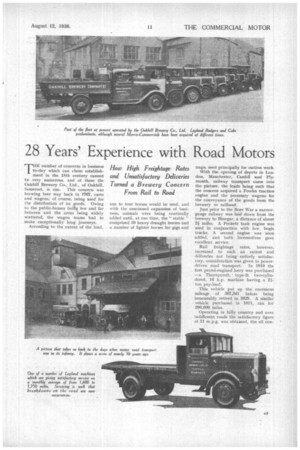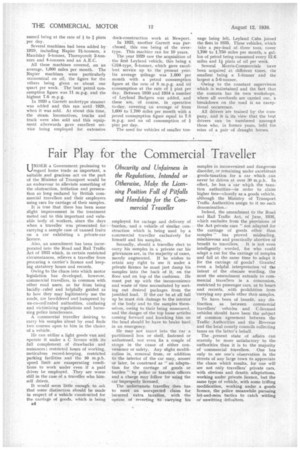28 Years' Experience with Road Motors
Page 37

Page 38

If you've noticed an error in this article please click here to report it so we can fix it.
How High Freightage Rates and Unsatisfactory Deliveries Turned a Brewery Concern From Rail to Road THE number of concerns in business to-day which can claim establishment in the 18th century cannot be very numerous, and of these the Oakhill Brewery Co., Ltd., of Oakhill, Somerset, is one. This concern was brewing beer way back in 1707, carts and wagons, of course, being used for the distribution of its goods. Owing to the public-houses being few and far between and the areas being widely scattered, the wagon teams had to make exceptionally long journeys.
According to the extent of the load, one to tour horses would be used, and with the continued expansion of business, animals were being continally added until, at one time, the "stable " comprised 30 heavy draught horses and a number of lighter horses for gigs and traps, used principally for station work.
With the opening of depots in London, Manchester, Cardiff and Plymouth, railway transport came into the picture, the loads being such that the concern acquired a Fowler traction engine and the necessary wagons for the conveyance of the goods from the brewery to railhead.
Just prior to the Boer War a narrowgauge railway was laid down from the brewery to Binegar, a distance of about 21 miles, A Peckett tank engine was used in conjunction with low, bogie trucks. A second engine was soon added, and both locomotives gal.n.: excellent service.
Rail freightage rates, howevet, increased to such an extent and deliveries not being entirely satisfactory, consideration was given to powerdriven road transport. In 1910 the first petrol-engined lorry was purchased —a Thornycroft,' type-B, two-cylindered, 10 h.p. machine having a 2iton pay-load.
This vehicle put up the enormous mileage of 307,341 before being honourably retired in 1929. A similar vehicle purchased in 1911, ran for 290,000 miles.
Operating in billy country and over indifferent roads the satisfactory figure of n m.p.g. was obtained, the oil con
sumed being at the rate of to I pints per day.
Several machines had been added by 1919, including Napier 24-tonners, a Maudslay 5-tonner, Thornycroft 2-tonfurs and 4-tonners and an A.E.C.
All these machines covered, on an average, 1,600 miles per month. The Napier machines were particularly economical on oil, the figure for the others being given as about one quart per week. The best petrol tonsum ption figure was 11 m.p.g, and the highest 7.6 m.p g.
In 1920 a Garrett undertype steamer was added and this ran until 1929, when it was sold. At about this time, the steam locomotives, trucks and track were also sold and this equipment afterwards gave excellent service being employed for extensive dock-construction work at Newport.
In 1923, another Garrett was purchased, this one being of the overtype. This machine ran for 10 years.
The year 1929 saw the acquisition of the first Leyland vehicle, this being a GH4-type, 5-tonner, which gave excellent service up to the present year. Itsaverage mileage was 1,600 per month with a petrol consumption figure at the rate of 8 m.p.g. and oil consumption at the rate of 4 pint per day. Between 1930 and 1934 a number of Leyland Badgers was added, and these are, of coarse, in operation to-day. covering an average of from 1,600 to 1,700 miles per month with a petrol consumption figure equal to 7.8 m.p.g. and an oil consumption of pint per day.
The need for vehicles of smaller ton nage being felt, Leyland Cubs joined the fleet in 1935. These vehicles, which take a pay-load of three tons, cover 1,700 to 1,750 miles per month, a gallon of petrol being consumed every 12.6 miles and 14 pints of oil per week.
Several Morris-Commercials have been acquired at diffeient times, the smallest being a 1-tonner and the largest a 5-6-tonner.
Owing to the constant supervision which is maintained and the fact that the concern has its own workshops. where all overhauls are carried out, a breakdown on the road is an exceptional occurrence.
All drivers are trained by the company, and it is its view that the best drivers can be numbered amongst those who, in former years, held the reins of a pair of draught horses.




















































































